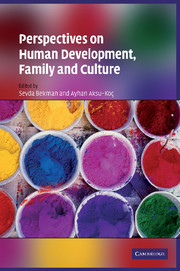Book contents
- Frontmatter
- Contents
- List of figures
- List of tables
- List of contributors
- Preface
- Foreword
- Selected international publications by Çiğdem Kağıtçıbaşı
- I Cultural and cross-cultural psychology: selected perspectives
- II Development in the family context
- III Culture and self
- 9 In search of autonomous-relational self-construal
- 10 Culture and developmental pathways of relationship formation
- 11 Microgenesis of narrative competence during preschool interactions: Effects of the relational context
- 12 Self-development, individuation, and culture: A psychoanalytic search
- IV Social change, family, and gender
- V Induced change
- Epilogue
- Subject Index
- Author Index
- References
10 - Culture and developmental pathways of relationship formation
Published online by Cambridge University Press: 04 August 2010
- Frontmatter
- Contents
- List of figures
- List of tables
- List of contributors
- Preface
- Foreword
- Selected international publications by Çiğdem Kağıtçıbaşı
- I Cultural and cross-cultural psychology: selected perspectives
- II Development in the family context
- III Culture and self
- 9 In search of autonomous-relational self-construal
- 10 Culture and developmental pathways of relationship formation
- 11 Microgenesis of narrative competence during preschool interactions: Effects of the relational context
- 12 Self-development, individuation, and culture: A psychoanalytic search
- IV Social change, family, and gender
- V Induced change
- Epilogue
- Subject Index
- Author Index
- References
Summary
I met Çiğdem at various IACCP conferences over the last decades in various functions. The distant perspective of an intellectually much appreciated colleague turned over the years into a close and wonderful friendship. Çiğdem's enthusiasm and devotion for her work and her message is inspiring for students and colleagues. Her interpersonal warmth and her sense of humour make all the encounters with her special. I feel privileged to have had many great moments with her and I truly want many more to come.
Heidi Kellerm: No, I like it but I'm just thinking the child should not grow up only in the world of herself and the mother.
i: Okay.
m: You need to bring other people into her life because you cannot just grow up with your child. There are moments, for instance if she [the mother] dies now, the child will find it difficult getting closer to another person. Though the mother and the child need to have their own relationship, when you are making a relationship with the child [you must] allow her to interact with other people. So that, if you are not there, she can easily get closer to other people. Like in this situation when you are always there with the child, immediately you are not there she looks for that familiar face and when she does not find the face, no matter what any other person does it cannot really satisfy her.
(Excerpt from an interview with a Cameroonian Nso mother about the best care for an infant)m: And sometimes they do need time away – uhm –, 'cause they get overstimulated if there are just too many people around.[…]
- Type
- Chapter
- Information
- Perspectives on Human Development, Family, and Culture , pp. 157 - 177Publisher: Cambridge University PressPrint publication year: 2009
References
- 10
- Cited by



